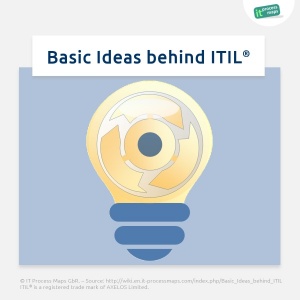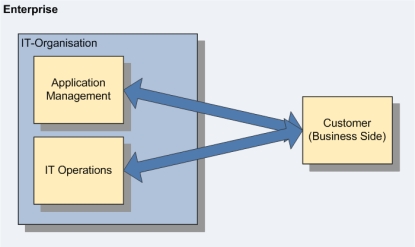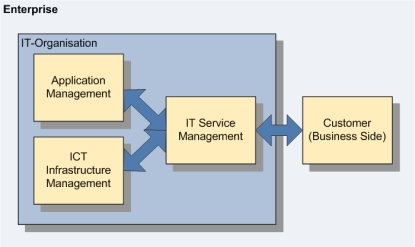Basic Ideas behind ITIL: Difference between revisions
mNo edit summary |
No edit summary |
||
| (3 intermediate revisions by 2 users not shown) | |||
| Line 1: | Line 1: | ||
< | <itpmch><title>Basic Ideas behind ITIL | IT Process Wiki</title> | ||
<meta name="keywords" content="itil basic, basic itil, itil concepts, itil idea" /> | |||
<meta name="description" content="The key to successfully using ITIL® is a good understanding of the ideas and principles behind the IT Infrastructure Library." /> | |||
<meta property="og:url" content="https://wiki.en.it-processmaps.com/index.php/Basic_Ideas_behind_ITIL" /> | |||
<meta property="og:title" content="Basic Ideas behind ITIL | IT Process Wiki" /> | |||
<meta property="og:description" content="The key to successfully using ITIL® is a good understanding of the ideas and principles behind the IT Infrastructure Library. Once these principles are understood, service providers are in a position to decide which ITIL processes address their specific requirements, and to adopt those parts of the ITIL advice that solve their particular needs." /> | |||
<meta property="og:site_name" content="IT Process Wiki - the ITIL® Wiki"> | |||
<meta property="og:type" content="website" /> | |||
<meta property="fb:admins" content="100002035253209" /> | |||
<meta property="fb:admins" content="100002592864414" /> | |||
<meta property="og:image" content="https://wiki.en.it-processmaps.com/images/6/69/Itil-basic-concepts.jpg" /> | |||
<meta property="og:image:width" content="600" /> | |||
<meta property="og:image:height" content="600" /> | |||
<link href="https://plus.google.com/108613479011811316823/posts" rel="publisher" /> | |||
</itpmch> | |||
<imagemap> | <imagemap> | ||
Image:ITIL-Wiki-deutsch.jpg|right|Basic Ideas behind ITIL | Image:ITIL-Wiki-deutsch.jpg|right|Basic Ideas behind ITIL | ||
| Line 7: | Line 21: | ||
<br style="clear:both;"/> | <br style="clear:both;"/> | ||
ITIL® describes several processes, organized around five [[ITIL_Processes#ITIL_Processes_according_to_ITIL_2011|service lifecycle stages]]. An example would be the [[Incident Management]] process in the [[ITIL Service Operation|Service Operation]] stage. | |||
So it is tempting to conclude that "adopting ITIL" means "implementing" the ITIL processes as described in the books, one after another. | |||
[[image:Itil-basic-concepts.jpg|thumb|300px|right|alt=ITIL basic ideas and concepts|link=https://wiki.en.it-processmaps.com/index.php/File:Itil-basic-concepts.jpg|ITIL basic concepts and ideas]] | |||
<blockquote>Yet these processes cannot be seen in isolation.</blockquote> | |||
[[ | The purpose of the [[ITIL Processes|ITIL processes]] is to bring to bear a number of key principles, and in many cases a number of ITIL processes work together to achieve a common goal. | ||
This approach | <blockquote>And what is more, ITIL is not a standard but a set of recommendations.</blockquote> | ||
* Operational requirements, ensuring the error-free running of an application, | |||
* IT | Organizations that wish to adopt the ITIL approach will have to adapt the ITIL advice to their particular situation and needs. There is no question of implementing every ITIL process to the letter. | ||
<html><span id="md-webpage-description" itemprop="description">The key to successfully using ITIL® is a good understanding of the ideas and principles behind the IT Infrastructure Library. Once these principles are understood, service providers are in a position to decide which ITIL processes address their specific requirements, and to adopt those parts of the ITIL advice that solve their particular needs.</span></html> | |||
There is no definitive list of ITIL principles, so the list below should be seen as a summary of some ''important key ideas behind ITIL''.<br /> | |||
<br style="clear:both;"/> | |||
==Strategic thinking== | |||
Strategic thinking helps service providers stay relevant in the longer term. | |||
Once in a while, organizations should take time to assess their current situation and likely future developments. Based on this assessment, they should define a strategy or road-map, for example for developing new capabilities and service offerings. | |||
* Strategic thinking in ITIL is covered to a large extent by the [[ITIL Strategy Management|Strategy Management]] process. | |||
* But other processes contribute, too: For example, the [[Business Relationship Management]] process ensures that service providers learn about the customers' needs - which are an important input for developing the Service Strategy. | |||
==Customer focus== | |||
Customer-focus is about keeping customers happy and providing adequate services for certain groups of customers, based on their needs. | |||
To this end, service providers should understand their customers' needs, design a range of services according to those needs, and collect feedback from their customers. | |||
ITIL processes that contribute to customer-centricity are, for example, | |||
* [[Business Relationship Management]] | |||
* and [[Service Review]], | |||
* but also [[Incident Management]] where we collect customer feedback after resolving [[Incident_Management#Incident|incidents]]. | |||
==Service definitions== | |||
Delivering services to expectations is an all-important theme in ITIL, and this is not possible if the services are not properly defined. | |||
So service definitions are very important concept in ITIL, and ITIL refers to several documents for defining the services, such as | |||
* [[Checklist SLA OLA|Service Level Agreements (SLAs)]], | |||
* [[Checklist SLA OLA|Operational Level Agreements (OLAs)]] | |||
* and [[Checklist Underpinning Contract (UC)|Underpinning Contracts (UCs)]]. | |||
There are a number of processes in ITIL where we define the service properties: | |||
* [[Service Level Management]] has overall responsibility for creating Service Level Agreements, | |||
* while other processes such as [[Availability Management|Availability]] and [[Capacity Management]] take care of defining specific aspects of the services. | |||
All services with their properties are listed in the [[Checklist Service Portfolio|Service Portfolio]]. | |||
==Excellent customer support== | |||
ITIL puts strong emphasis on creating a good customer experience, based on a consistent, professional approach to managing Incidents and Service Requests. | |||
Good customer support obviously means resolving incidents swiftly and keeping customers informed. But customer support is also about detecting issues early, so incidents can be dealt with before a large number of users are affected. | |||
Accordingly, [[Incident Management]] and [[Request Fulfilment]] are essential ITIL processes for creating the perfect customer experience. | |||
In addition, the Event and Problem Management processes try to keep the number of incidents low: | |||
* [[Event Management]] ensures that any deviations from normal operation are detected before they develop into incidents, | |||
* while [[Problem Management]] takes care of resolving the root causes of recurring incidents. | |||
==Continual improvement== | |||
The purpose of [[ITIL CSI - Continual Service Improvement|Continual Service Improvement (CSI)]] is to avoid dangerous stagnation. | |||
The world around us is changing all the time, and we have to ask ourselves on a regular basis if we are doing a good job or if there is anything that could be done in a different, better way. | |||
Continual improvement has a long history and it is often associated with a well-established management method for continual improvement, known as the "Deming Cycle" with four steps: [https://en.wikipedia.org/wiki/PDCA Plan, Do, Check, and Act]. | |||
Continual Service Improvement is the last of the five [[ITIL_Processes#ITIL_Processes_according_to_ITIL_2011|ITIL service lifecycle stages]], and it is here where most of the improvement activities take place. But many other ITIL processes provide crucial inputs for service improvement. For example, [[Service Level Management]] contains activities for producing [[Checklist Service Level Report|Service Level Reports]] with statistics about agreed vs. achieved service levels. | |||
==IT Service Management as interface between IT and the business== | |||
'''''Traditional setup of the IT organization''''' | |||
[[Image:traditional_setup_it_organisation.jpg|frame|right|link=https://wiki.en.it-processmaps.com/index.php/File:Traditional_setup_it_organisation.jpg|Traditional Setup of the IT Organization]] | |||
Traditionally, there were two separate channels for the communication between the IT organization and the business: One channel between the client and application development for the development or modification of applications, and a second channel for operational isssues. | |||
This approach suffers from several drawbacks: | |||
* Operational requirements, ensuring the error-free running of an application, may not be taken into account during the development phase. | |||
* IT operations is not fully able to control the release of applications into the productive environment; this might cause unforeseen side effects. | |||
<br style="clear:both;"/> | <br style="clear:both;"/> | ||
'''''Setup of the IT organization according to ITIL''''' | |||
[[Image:setup_it_organisation_itil.jpg|frame|right|Setup of the IT | [[Image:setup_it_organisation_itil.jpg|frame|right|link=https://wiki.en.it-processmaps.com/index.php/File:Setup_it_organisation_itil.jpg|Setup of the IT Organization according to ITIL]] | ||
An [[ITIL Implementation|implementation method based on ITIL]] | An [[ITIL Implementation|implementation method based on ITIL]] resolves these problems by placing IT service management after application Management and ICT infrastructure management: Thus, IT service management mediates between development and production on the side of the IT organization, and the client on the business-side. | ||
The activities in | The activities in application development and IT operations are now co-ordinated and there is one communication channel for the provision of IT "as a service". | ||
<br style="clear:both;"/> | <br style="clear:both;"/> | ||
<p> </p> | |||
<html>By:  Andrea Kempter <a rel="author" href="https://www.linkedin.com/in/andreakempter"><img style="margin:0px 0px 0px 0px;" src="/images/bookmarking/linkedin.png" width="16" height="16" title="By: Andrea Kempter | Profile on LinkedIn" alt="Author: Andrea Kempter, IT Process Maps GbR" /></a>  and  Stefan Kempter <a href="https://www.linkedin.com/in/stefankempter"><img style="margin:0px 0px 0px 0px;" src="/images/bookmarking/linkedin.png" width="16" height="16" title="By: Stefan Kempter | Profile on LinkedIn" alt="Contributor: Stefan Kempter, IT Process Maps GbR" /></a>, IT Process Maps. | |||
<p><small> | |||
<span itemprop="breadcrumb" itemscope itemtype="http://schema.org/BreadcrumbList"> | |||
<span itemprop="itemListElement" itemscope itemtype="http://schema.org/ListItem"> | |||
<a itemprop="item" href="https://wiki.en.it-processmaps.com/index.php/Basic_Ideas_behind_ITIL#Strategic_thinking"> <span itemprop="name">Strategic thinking</span></a><meta itemprop="position" content="1" /></span> › | |||
<span itemprop="itemListElement" itemscope itemtype="http://schema.org/ListItem"> | |||
<a itemprop="item" href="https://wiki.en.it-processmaps.com/index.php/Basic_Ideas_behind_ITIL#Customer_focus"> <span itemprop="name">Customer focus</span></a><meta itemprop="position" content="2" /></span> › | |||
<span itemprop="itemListElement" itemscope itemtype="http://schema.org/ListItem"> | |||
<a itemprop="item" href="https://wiki.en.it-processmaps.com/index.php/Basic_Ideas_behind_ITIL#Service_definitions"> <span itemprop="name">Service definitions</span></a><meta itemprop="position" content="3" /></span> › | |||
<span itemprop="itemListElement" itemscope itemtype="http://schema.org/ListItem"> | |||
<a itemprop="item" href="https://wiki.en.it-processmaps.com/index.php/Basic_Ideas_behind_ITIL#Excellent_customer_support"> <span itemprop="name">Excellent customer support</span></a><meta itemprop="position" content="4" /></span> › | |||
<span itemprop="itemListElement" itemscope itemtype="http://schema.org/ListItem"> | |||
<a itemprop="item" href="https://wiki.en.it-processmaps.com/index.php/Basic_Ideas_behind_ITIL#Continual_improvement"> <span itemprop="name">Continual improvement</span></a> | |||
<meta itemprop="position" content="5" /></span> | |||
</span> | |||
</small></p> | |||
<!-- define schema.org/WebPage --> <span itemscope itemtype="https://schema.org/WebPage" itemref="md-webpage-description"> | |||
<meta itemprop="name Headline" content="Basic Ideas behind ITIL" /> | |||
<meta itemprop="alternativeHeadline" content="ITIL concepts" /> | |||
<link itemprop="url" href="https://wiki.en.it-processmaps.com/index.php/Basic_Ideas_behind_ITIL" /> | |||
<link itemprop="primaryImageOfPage" href="https://wiki.en.it-processmaps.com/images/6/69/Itil-basic-concepts.jpg" /> | |||
<meta itemprop="inLanguage" content="en" /> | |||
<link itemprop="citation" href="https://wiki.de.it-processmaps.com/index.php/ITIL-Leitgedanken" /> | |||
<link itemprop="author" href="https://www.linkedin.com/in/andreakempter" /> | |||
<meta itemprop="author" content="Andrea Kempter" /> | |||
<meta itemprop="creator copyrightHolder publisher" content="IT Process Maps" /> | |||
</span><p></html> | |||
<!-- This page is assigned to the following categories: --> | <!-- This page is assigned to the following categories: --> | ||
[[Category:IT Infrastructure Library ITIL]] | [[Category:IT Infrastructure Library ITIL]] | ||
<!-- --- --> | <!-- --- --> | ||
Latest revision as of 12:04, 30 March 2019

ITIL® describes several processes, organized around five service lifecycle stages. An example would be the Incident Management process in the Service Operation stage.
So it is tempting to conclude that "adopting ITIL" means "implementing" the ITIL processes as described in the books, one after another.

Yet these processes cannot be seen in isolation.
The purpose of the ITIL processes is to bring to bear a number of key principles, and in many cases a number of ITIL processes work together to achieve a common goal.
And what is more, ITIL is not a standard but a set of recommendations.
Organizations that wish to adopt the ITIL approach will have to adapt the ITIL advice to their particular situation and needs. There is no question of implementing every ITIL process to the letter.
The key to successfully using ITIL® is a good understanding of the ideas and principles behind the IT Infrastructure Library. Once these principles are understood, service providers are in a position to decide which ITIL processes address their specific requirements, and to adopt those parts of the ITIL advice that solve their particular needs.
There is no definitive list of ITIL principles, so the list below should be seen as a summary of some important key ideas behind ITIL.
Strategic thinking
Strategic thinking helps service providers stay relevant in the longer term.
Once in a while, organizations should take time to assess their current situation and likely future developments. Based on this assessment, they should define a strategy or road-map, for example for developing new capabilities and service offerings.
- Strategic thinking in ITIL is covered to a large extent by the Strategy Management process.
- But other processes contribute, too: For example, the Business Relationship Management process ensures that service providers learn about the customers' needs - which are an important input for developing the Service Strategy.
Customer focus
Customer-focus is about keeping customers happy and providing adequate services for certain groups of customers, based on their needs.
To this end, service providers should understand their customers' needs, design a range of services according to those needs, and collect feedback from their customers.
ITIL processes that contribute to customer-centricity are, for example,
- Business Relationship Management
- and Service Review,
- but also Incident Management where we collect customer feedback after resolving incidents.
Service definitions
Delivering services to expectations is an all-important theme in ITIL, and this is not possible if the services are not properly defined.
So service definitions are very important concept in ITIL, and ITIL refers to several documents for defining the services, such as
- Service Level Agreements (SLAs),
- Operational Level Agreements (OLAs)
- and Underpinning Contracts (UCs).
There are a number of processes in ITIL where we define the service properties:
- Service Level Management has overall responsibility for creating Service Level Agreements,
- while other processes such as Availability and Capacity Management take care of defining specific aspects of the services.
All services with their properties are listed in the Service Portfolio.
Excellent customer support
ITIL puts strong emphasis on creating a good customer experience, based on a consistent, professional approach to managing Incidents and Service Requests.
Good customer support obviously means resolving incidents swiftly and keeping customers informed. But customer support is also about detecting issues early, so incidents can be dealt with before a large number of users are affected.
Accordingly, Incident Management and Request Fulfilment are essential ITIL processes for creating the perfect customer experience.
In addition, the Event and Problem Management processes try to keep the number of incidents low:
- Event Management ensures that any deviations from normal operation are detected before they develop into incidents,
- while Problem Management takes care of resolving the root causes of recurring incidents.
Continual improvement
The purpose of Continual Service Improvement (CSI) is to avoid dangerous stagnation.
The world around us is changing all the time, and we have to ask ourselves on a regular basis if we are doing a good job or if there is anything that could be done in a different, better way.
Continual improvement has a long history and it is often associated with a well-established management method for continual improvement, known as the "Deming Cycle" with four steps: Plan, Do, Check, and Act.
Continual Service Improvement is the last of the five ITIL service lifecycle stages, and it is here where most of the improvement activities take place. But many other ITIL processes provide crucial inputs for service improvement. For example, Service Level Management contains activities for producing Service Level Reports with statistics about agreed vs. achieved service levels.
IT Service Management as interface between IT and the business
Traditional setup of the IT organization

Traditionally, there were two separate channels for the communication between the IT organization and the business: One channel between the client and application development for the development or modification of applications, and a second channel for operational isssues.
This approach suffers from several drawbacks:
- Operational requirements, ensuring the error-free running of an application, may not be taken into account during the development phase.
- IT operations is not fully able to control the release of applications into the productive environment; this might cause unforeseen side effects.
Setup of the IT organization according to ITIL

An implementation method based on ITIL resolves these problems by placing IT service management after application Management and ICT infrastructure management: Thus, IT service management mediates between development and production on the side of the IT organization, and the client on the business-side.
The activities in application development and IT operations are now co-ordinated and there is one communication channel for the provision of IT "as a service".
By: Andrea Kempter ![]() and Stefan Kempter
and Stefan Kempter ![]() , IT Process Maps.
, IT Process Maps.
Strategic thinking › Customer focus › Service definitions › Excellent customer support › Continual improvement






